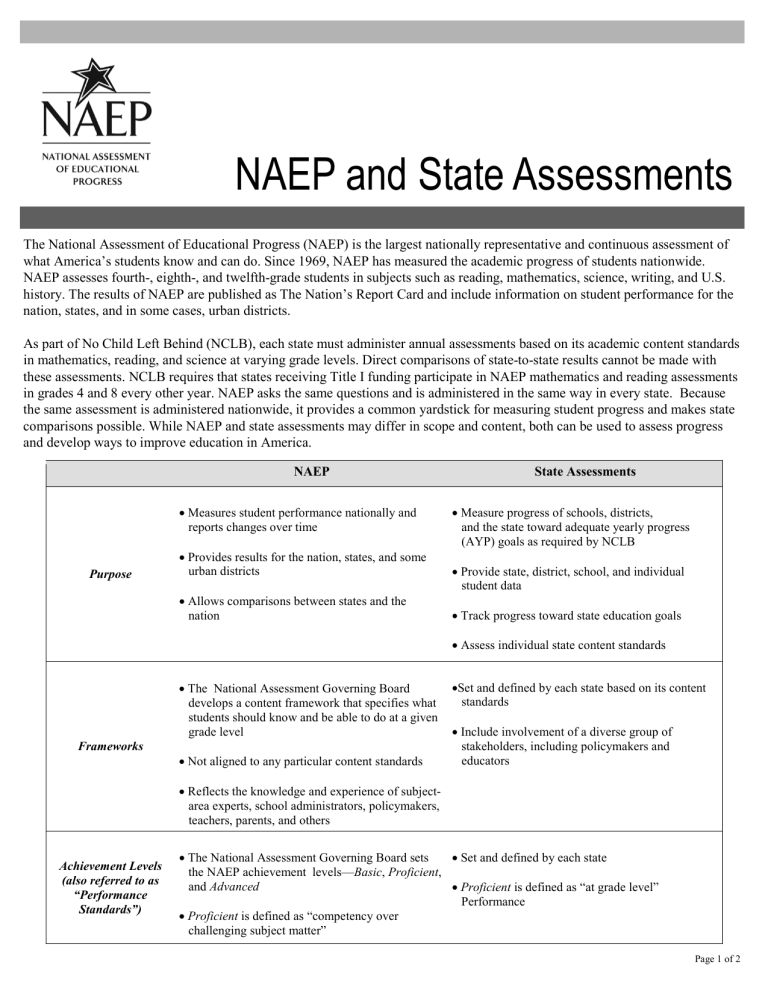NAEP and State Assessments

NAEP and State Assessments
The National Assessment of Educational Progress (NAEP) is the largest nationally representative and continuous assessment of what America’s students know and can do. Since 1969, NAEP has measured the academic progress of students nationwide.
NAEP assesses fourth-, eighth-, and twelfth-grade students in subjects such as reading, mathematics, science, writing, and U.S. history. The results of NAEP are published as The Nation’s Report Card and include information on student performance for the nation, states, and in some cases, urban districts.
As part of No Child Left Behind (NCLB), each state must administer annual assessments based on its academic content standards in mathematics, reading, and science at varying grade levels. Direct comparisons of state-to-state results cannot be made with these assessments. NCLB requires that states receiving Title I funding participate in NAEP mathematics and reading assessments in grades 4 and 8 every other year. NAEP asks the same questions and is administered in the same way in every state. Because the same assessment is administered nationwide, it provides a common yardstick for measuring student progress and makes state comparisons possible. While NAEP and state assessments may differ in scope and content, both can be used to assess progress and develop ways to improve education in America.
NAEP State Assessments
Purpose
•
Measures student performance nationally and
reports changes over time
•
Provides results for the nation, states, and some
urban districts
•
Allows comparisons between states and the
nation
•
Measure progress of schools, districts,
and the state toward adequate yearly progress
(AYP) goals as required by NCLB
•
Provide state, district, school, and individual
student data
•
Track progress toward state education goals
•
Assess individual state content standards
Frameworks
•
The National Assessment Governing Board
develops a content framework that specifies what
students should know and be able to do at a given
grade level
•
Not aligned to any particular content standards
•
Reflects the knowledge and experience of subject-
area experts, school administrators, policymakers,
teachers, parents, and others
•
Set and defined by each state based on its content
standards
•
Include involvement of a diverse group of
stakeholders, including policymakers and
educators
Achievement Levels
(also referred to as
“Performance
Standards”)
•
The National Assessment Governing Board sets
the NAEP achievement levels— Basic , Proficient ,
and Advanced
•
Proficient is defined as “competency over
challenging subject matter”
•
Set and defined by each state
•
Proficient is defined as “at grade level”
Performance
Page 1 of 2
NAEP and State Assessments
NAEP State Assessments
About the Assessment
•
Includes multiple-choice, short constructed-
response, extended-response, and computer-based
questions
•
Assesses students with disabilities and English
language learners based on NAEP allowable
accommodations
•
Administered by NAEP field staff during regular
school hours
•
Consist of a variety of formats, which vary by
state, such as multiple-choice, constructed-
response, performance events, portfolios,
alternative assessments, and computer-based
assessments
•
Assess students with disabilities and English
language learners according to the state’s
accommodation policy
•
Administered by school and district personnel
during regular school hours
Assessment
Participation
•
A representative sample of students in grades 4
and 8 from each state participate in reading
and mathematics every other year
•
National and state samples of fourth-,
eighth-, and twelfth-graders are periodically
assessed in other subject areas such as science,
writing, U.S. history, and civics
•
Student participation is voluntary but highly
encouraged
•
Students with disabilities and English language
learners who require test accommodations other than those allowed by NAEP can be excluded
•
All students in grades 3 through 8 are assessed
every year in reading and mathematics
•
Students in grades 3 through 8 are assessed at
least once in elementary (3-5) school and once
in middle (6-8) school in science
•
High school students are assessed at least once
in reading, mathematics, and science
•
Offer alternative or modified assessments, when
necessary, to students with disabilities and
English language learners
•
Participation is required for all schools
Assessment Results
•
Used by the President, Congress, and state
leaders to develop ways to improve education in
America
•
Makes comparisons between states and
the nation
•
Makes trend comparisons over time
•
Does not report performance for individual
schools, students, or most school districts
•
Used by governors, state legislatures, state
leaders, and state educators for setting education
policy and examining school and group
performance
•
Used by teachers, parents, and other school staff to
examine individual student performance
•
Aid in making local decisions about
curriculum and instruction
•
May also be used for promotion/retention
decisions and/or graduation requirements
•
May be used to inform state accreditation
decisions
NAEP is a congressionally-mandated project of the National Center for Education Statistics (NCES) within the Institute of
Education Sciences of the U.S. Department of Education.
For more information, visit http://nces.ed.gov/nationsreportcard
Page 2 of 2

